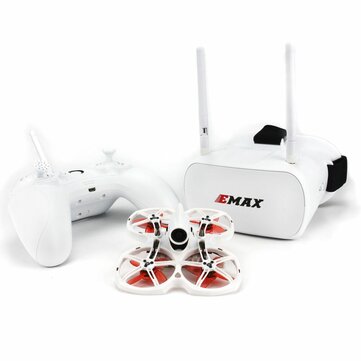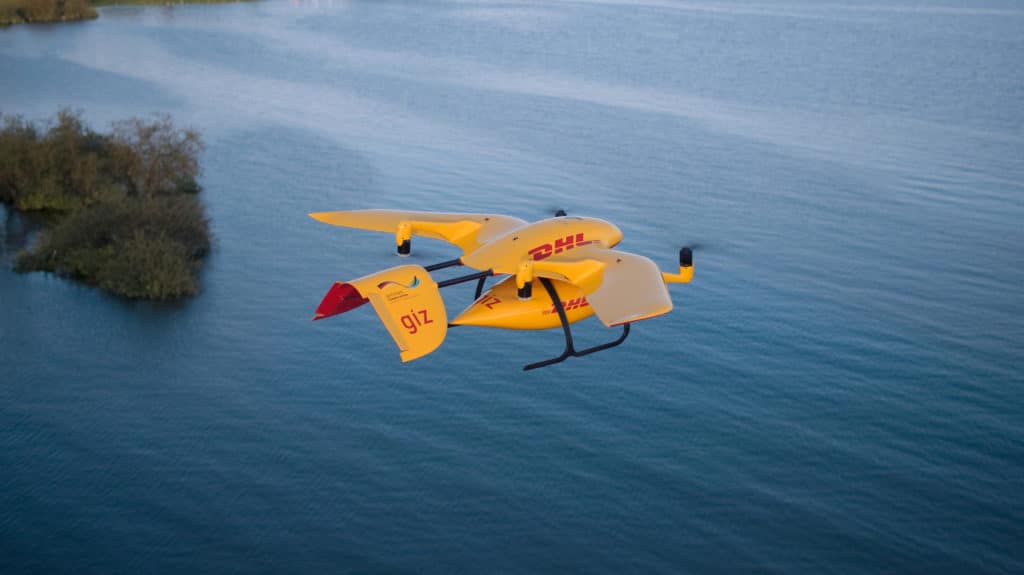Tiny whoops are one of the best and most versatile options for learning and honing your FPV skills! They are pre-built and generally made up of only a few components, which make them perfect for beginners.
If you’re looking at starting your journey into FPV drones, it can be daunting to see how much information is available. You might not know where to start but I assure you there is no better way to learn than just getting into it.
Quick Breakdown of Tiny Whoops
‘Tiny Whoop’ has become the term to refer to micro, ducted FPV drones sized approximately 65-85mm between motors. These are actually micro drones or micro whoops but the name has been adopted from the original model of the same name.
Here’s a few reasons why starting with a tiny whoop can be perfect, especially if your end goal is 5 inch racing and freestyle drones:
- Price – Tiny whoops can give you the necessary practice at often less than half the price of a full sized alternative.
- Toughness – Tiny whoops are very lightweight. They can handle the crashes you’ll inevitably make as a beginner. This will save you breaking parts on the larger drones which often cannot take as much of the same abuse.
- Indoor Flying – Weather is a drone pilots biggest hurdle for getting in the air. It really sucks to organise a day to fly, just to be grounded due to rain and wind. Due to their weight, size and propeller ducts/guards, you can fly them indoors or in small spaces at your own convenience.
- Pre-built – If you’re a beginner, it can be overwhelming when building a quad piece by piece. You won’t need to concern yourself with compatibility issues and learning to solder.
- Minimal Parts – Tiny whoops have all-in-one flight controllers (FC). This is a combination of your FC, electronic-speed-controllers (ESC), radio receivers and video transmitters, all in a single board. This makes it easy to dismantle and reassemble the aircraft to learn the individual parts, which is perfect for a beginner.
- No Additional Gear Required – If you order a bind-and-fly (BNF) with the appropriate radio receivers, you can use the corresponding radio transmitter/controller (RTX) that you might already have. With the right RTX, you can bind it to all of your drones, from tiny whoop to 5 inch.
Here’s what you’ll need to know about some of the terminology you’ll come across with these drones.
1S & 2S Variants
The terms 1S and 2S refers to the number of cells in the required battery. The more cells, the more power you can achieve.
The special thing about this category of drones is that in general, they use the same 1S batteries. A 2S drone simply uses 2 of them in series to achieve this (2 x 1S).
That said, a higher cell count does not necessarily mean a better drone. It is only a measure of how much voltage your battery can output to the motors.
Brushed & Brushless Motors
There are two primary motor types employed in a range of applications like drones: brushed and brushless. Brushed motors contain internal brushes, which generate friction and lead to faster wear and tear, reducing efficiency and lifespan.
On the other hand, brushless motors forgo the use of brushes, decreasing friction and boosting longevity. While they may come with a higher price tag, brushless motors deliver superior performance and efficiency, and necessitate minimal upkeep, making them the favored option for numerous applications, particularly in the world of drones.
My Top 5 Tiny Whoop Recommendations
As a beginner, it can get confusing with the seemingly unlimited options out there. My goal here is not to overwhelm you with choices, but really hone in on the best of the best to ease your decision making process.
To save you time, these will be in descending order starting with my number 1 pick. But first, a quick comparison table.
| Name | Size (mm) | Dry Weight (g) | Motor (kv) | Battery | Connector | Cost (USD) | |
| #1 | UZ65 | 65 | 21 | 19,000 | 1S | PH2.0 | ~$110 |
| #2 | Mobula6 | 65 | 20 | 25,000 | 1S | PH2.0 | ~$90 |
| #3 | Cetus X | 95 | 55 | 11,000 | 1S | BT2.0 | ~$320 |
| #4 | Tinyhawk II | 75 | 31 | 16,000 | 1-2S | PH2.0 | ~$120 |
| #5 | Moblite7 | 75 | 19.5 | 19,000 | 1S | PH 2.0 | ~$90 |
#1 – Eachine UZ65
The Eachine UZ65 is definitely my favourite tiny whoop for beginners. Last year, I recommended the US65/DE65 2S whoop because of its quality for cost. They are hard to come by these days and so I have to recommend its little brother, the UZ65.
Most top whoop lists are out of date, and include versions like the US65 and UK65 (non-pro), 1S drone.
This drone is on the smaller end of this category. At 65mm, this makes it super easy to fly indoors and through obstacles. You can hit some crazy gaps with confidence and ease (after some practice of course).

Unlike it’s 2S predecessor, this drone is a lot more forgiving! The learning curve isn’t so steep with this bad boy, but the durability is still there if needed. The frames are pretty much identical as far as I can tell, but the real benefit is that a PH2.0 battery connector comes as standard. The worst thing with the previous model was having to replace the ET2.0 on the drone because your batteries ran a different config, or you bought into the hype of the ET2.0 efficiency, and replaced all your batteries with those rare/hard-to-find connectors. (That was me, lol RIP).
Cons:
- Less powerful than my previous recommended first place aircraft which makes it less viable for outdoor use in windy conditions and it doesn’t have the same punch.
The upside: Easier to learn for the beginners which is what this list is about. - The camera is downgraded from the Caddx Ant to a Runcam Nano3. I personally feel that’s a loss of quality but that’s my subjective opinion.
The upside: This is probably one of a few reasons why they have managed to keep the price low on this aircraft, which is what you want when you’re new to this hobby.
Specifications
| Size (mm) | Dry Weight (g) | Motor (kv) | Battery | Connector | Cost (USD) |
| 65 | 21 | 19,000 | 1S | PH 2.0 | ~$110 |
#2 – Happymodel Mobula6 (25,000kv)
The Mobula6 has been on the top of everyone’s list in this FPV hobby for the last couple of years. It just misses my top spot by an inch.
The Mobula6 comes in a few different variations:
- 25,000kv
- 19,000kv
- HD
In this list, I’m speaking specifically of the 25,000kv (we’ll just call it 25K) version of the whoop. I think the 25K is the best value of the bunch due to its power. Although it has a reduced flight time in comparison with the alternative, the pure enjoyment is worth it.

And due to its budget price point, the 25K rates higher as a beginner drone in comparison to the more expensive HD version. Especially for those who are just testing the waters and aren’t ready to commit too much money up front. Some would argue HD is overrated anyways. (not me)
Even though this is a 1S set-up, the 25K packs a similar performance profile to Eachine US65 Pro mentioned in my number 1 slot. However, the flight time was more than 30% less, and that’s why it loses out.
So, why not opt for the 19K if the flight time is a problem? As a beginner, you might consider the 19K if that is your biggest concern. I recommend the 25K for when you improve enough to take your flying outdoors, or at a faster speed.
It will save you money on needing to upgrade if you simply learn to control the harder version first. You are free to disagree, and the 19K would still be a great choice.
Another great thing about it, is that it uses a PH2.0 battery connector. This is a far more common 1S connector. It is lower priced, more readily available and easy to find. If you already fly tiny whoops, you should already have these batteries.
Cons:
- Reduced flight time – You can expect less than 2 minutes on a regular run with the 25K. Some people report that the 19K can fly up to 4 minutes. (I’ve never seen it.)
The upside: It handles the outdoor elements a lot better and you have a higher maximum speed for when you get better at piloting it. It’ll serve as a great racing practice drone. - Limited receiver options – The receiver options are limited to FrSky and Flysky.
The upside: I recommend Taranis Q X7 Radio Transmitter, which is a great beginner drone, and will lead you into the intermediate levels. You won’t need to upgrade for a while, and it’s compatible with most of these tiny whoop options.
Specifications
| Size (mm) | Dry Weight (g) | Motor (kv) | Battery | Connector | Cost (USD) |
| 65 | 20 | 25,000 | 1S | PH 2.0 | ~$90 |
#3 – BetaFPV Cetus
The BetaFPV Cetus is another new addition to this list. It comes in a few different packages.
In this case, I would suggest the Cetus X option, although it makes it the biggest and most expensive entry on this list. You won’t have to upgrade so quickly so it’s a decent investment.
This drone is also the only one on this list with quality-of-life features, like stabilisation and turtle mode right out of the box.

I hesitate to put it this high up the list because the aircraft so user friendly, I feel like you might lose out on the hard lessons of crashing a million times. Maybe that’s just old school.
This is because the drone has a stabilisation feature, that allows you to level out. This is normally done by pushing forward and back on the pitch control which is a great skill to have.
Alas, I have to admit, I wasted a lot of time crashing in my first 2 weeks. If I had these features, the transition wouldn’t have been so rough.
A big advantage for the BetaFPV range, is considered to be the battery connector. Whilst traditional PH2.0 connectors limit current to 5A, BetaFPV claims that the BT2.0 goes all the way up to 9A. Some user testing say that the voltage gains are increased by almost 10% while within the optimal 3.6-4.35V range. It’s impressive what a simple connector can do.
Cons:
- BT2.0 connector is less available than the PH2.0 alternative. It reduces your options and the availability is limited. Even if you converted your other batteries to BT2.0 for the benefit, the soldering is difficult due to the way they are joined.
The upside: They are considered the best on the market if you’re looking to maximise performance. - The price is is 300% higher than the great alternatives in the class of drone
The upside: If price isn’t a concern, you’ll have more choice of radio receivers. - The quality-of-life features may hold your hand a bit too much for my liking.
The upside: It is undoubtedly a useful feature for beginners and it will save them a lot of time in learning the basic controls. Exponentially better for those who have never flown any drone before or even played a video game.
Specifications
| Size (mm) | Dry Weight (g) | Motor (kv) | Battery | Connector | Cost (USD) |
| 95 | 55 | 11,000 | 1S | BT2.0 | ~$320 |
#4 – EMAX Tinyhawk II
The Tinyhawk 2 is an awesome addition to this list, especially due to its flexibility of 1 and 2S options.
If you’re looking for a Ready-to-fly kit, with FPV goggles and a radio in one, the EMAX Tinyhawk II comes with a great package. The RTF kit is approximately $190 USD which is great value to get you into the hobby and flying straight away.
Even though it weighs 10g more than most options on this list, with 16,000kv motors, and a 2S input, this baby can go wild even in some decent wind outdoors. This has the most thrust on this list by far!

The price point for the drone itself is a bit higher in this category, being close to the BetaFPV Metor65, but in this case, it makes sense. The 75mm frame and 4 bladed Avan propellers, plus the frame mould and camera casing add up to justify the cost.
Cons:
- Changing between 1S & 2S – I know this should be a great thing and I agree that it is. The only reason this is a con is that you have to plug the drone in everytime you decide to use a different battery type, to change the PID and rate profiles.
The upside: The drone should detect which battery you are using and change PID profiles, but if not, you can set that up in BetaFlight to be automatic. As for the rates, you can set that option in your radio to save you time. The whole process is annoying and I’d rather they just kept this a 2S limited drone. - EMAX receiver – This is intended to be sold as a Ready-to-fly kit with EMAX goggles and a radio. That means the receiver is made for specifically for the RTF kit.
The upside: You can bind via D8 mode on a FrSky radio like my recommended Taranis Q X7. - LED Lights – The Tinyhawk 2 comes with a strip of LED lights under each of the propellers. For such a small drone, I don’t find it necessary to draw power away from the core flight functions.
The upside: They do look pretty cool, and it is a feature unique to this drone. Especially on my list here.
Specifications
| Size (mm) | Dry Weight (g) | Motor (kv) | Battery | Connector | Cost (USD) |
| 75 | 31 | 16,000 | 1S & 2S | PH 2.0 | ~$120 |
#5 – Happymodel Moblite7
The final addition on my list is the Moblite7 This whoop’s best feature is its lightweight nature.
I’ve added this on the list to provide a meaningful option for those looking to maximise their flight time.

Some reports have claimed upwards of 7 minutes worth of flight, which is over triple the average for the tiny whoop class. I generally fly these in the 4 minute range just to be safe, but I can be overly conservative.
This is a matter of durability vs flight time. It trades the protection of a large encasing frame, for increased flight time and flight performance. It is up to you if you think that this is a worthwhile option.
There is a 65mm variant called the Moblite6 that provides a similar experience but that is rare to find this year.
Cons:
- The propellers often loosen and move up the motor shaft.
The upside: It’s an easy fix, just push them down when you notice. - The minimal design means that a lot of your electronic components are exposed. The flight controller board is unprotected without the standard canopy.
The upside: You achieve power comparable to 25,000kv motors on other drones due to the light weight. - The battery mount loosens over time and can cause your batteries to fall out of the mount.
The upside: You can use a larger variety of batteries due to the extra space, and can fix this problem with a rubber band or something similar.
Specifications
| Size (mm) | Weight (g) | Motor (kv) | Battery | Connector | Cost (USD) |
| 75 | 19.5 | 19,000 | 1S | PH 2.0 | ~$120 |
Final Thoughts
Tiny whoops are a great tool for beginners. These are currently my favourite 5, but with new ones continuously hitting the market, my opinions may change over time. You’re going to crash them
For now, I’d say get the cheapest one you can find and get flying. They’re all fun, and you can worry about the nuances later. Don’t get stuck in analysis paralysis. You’re going to crash whatever you start with so a tiny whoop is a great place to begin as they can handle some damage.
Flying > Researching
– Defining Drones Team
If you’ve got a tiny whoop that you’d like me to test out, feel free to drone a message in my contact form.
If you’re wondering why tiny whoops and other drones have such short flight times, check out my other article, Why Do Drones Have Such A Short Battery Life?




